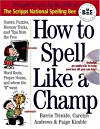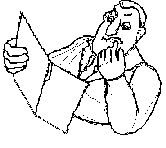

| Book of the Month | ||
 |
How to Spell like a Champ |  |
Publisher: Workman Publishing Company
Authors: Barrie Trinkle, Carolyn Andrews, Paige Kimble
$10.95
ISBN 0761143696
English spelling is one of the more challenging parts of the language, and something that even people born into an English-speaking environment struggle to get right. For every 'spelling rule' there are many exceptions. For example the 'rule' of 'i before e except after c' works well except for 'science', 'weigh', 'neighbour', 'vacancies' and a few dozen other words. In fact so challenging is the art of spelling English words that it has become a competitive sport. The 'Spelling Bee' is a competition where contestants are asked to spell increasingly difficult words, with the winner going on to the next round. This is particularly popular among schoolchildren in the United States, where there is even a national competition, with the final shown on a sports network TV station. By tradition the national spelling champ gets to meet the President of the USA afterwards. However, even if you don't want to appear on national TV and meet politicians, good spelling helps with things like class essays and letters to your bank manager; so this book is of value to everyone who has ever wondered how to spell words like 'grievance' or 'hacienda'or bennial, bianneil, biannial 'every two years'.
There are seven chapters in this 220-page book and an accompanying CD which is particularly useful for those language students who have trouble with individial letters that sound different to what they expect. (For example many European languages pronounce letter i as e.) The first chapter of the book can be skipped by those who are not interested in Spelling Bee contests, their history and organization. However, even here there are very useful lists of words - for example the list of words that have failed finalists includes words that might well also be a language student's downfall. So having lists of tricky words such as 'chrysanthemum' all in one place makes a handy reference for practising. There are other lists throughout the book, usually collected into themes such as 'parts of the body' or 'foods'. There are about 20 words in every list.
After chapter one the book gets down to the practical details of how to spell. We learn how to guess a spelling from how a word is pronounced, and the many spelling rules and the even more numerous exceptions. This book helps not just with spelling but also with vocabulary, as it shows how to find the root of a word, and how the rest of the word is built on this foundation. Once you know your word root, you might be able to guess whether the origin of the word comes from (for example) Latin, Old English or Greek. This is useful because once you know the root language, you know what spelling rules might be used. For example if you are not sure of whether to use c or k, remember that Anglo-Saxon words are more likely to use c and 'foreign' words a k.
After p.165 of this book there are a number of vocabulary and spelling games, such as a word square in which only the thirty words of Greek origin count towards your score. The book has a cheerful style with abundant pictures, photographs and sidebars with extra information. Despite the numerous graphics the publishers have managed to keep the book at a reaasonable cost - something many glossy EFL textbooks fail to do.
Who is this book for? The authors evidently have native speakers at the secondary school level as their primary target audience. However, the clear explanations and useful vocabulary lists mean that this is a useful book for any language students below the Upper-intermediate level. The rather large size makes this a poor pocket book, but a student with a rucksack or school bag will find this a useful book to read during otherwise vacant time, such as when in a waiting room or on a bus.
Verdict: Tries hard to make spelling fun, and almost succeeds
Assessment 8/10